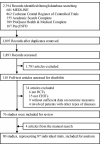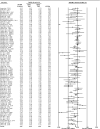Effects of consumer-oriented health information technologies in diabetes management over time: a systematic review and meta-analysis of randomized controlled trials
- PMID: 28340030
- PMCID: PMC7651962
- DOI: 10.1093/jamia/ocx014
Effects of consumer-oriented health information technologies in diabetes management over time: a systematic review and meta-analysis of randomized controlled trials
Abstract
Objective: To reveal the effects of consumer-oriented health information technologies (CHITs) on patient outcomes in diabetes management over time through systematic review and meta-analysis.
Methods: We searched 5 electronic databases (from database inception to July 2016) for studies that reported on randomized controlled trials examining the effects of CHITs on glycemic control and other patient outcomes in diabetes management. Data were analyzed using either meta-analysis or a narrative synthesis approach.
Results: Eighty randomized controlled trial studies, representing 87 individual trials, were identified and included for analysis. Overall, the meta-analysis showed that the use of CHITs resulted in significant improvement in glycemic control compared to usual care (standardized mean difference = -0.31%, 95% confidence interval -0.38 to -0.23, P < .001) in patients with diabetes. Specifically, improvement in glycemic control was significant at intervention durations of 3, 6, 8, 9, 12, 15, 30, and 60 months, while no significant differences were found at other time points reported. The narrative synthesis provided mixed effects of CHITs on other clinical, psychosocial, behavioral, and knowledge outcomes.
Conclusions: The use of CHITs appears to be more effective than usual care in improving glycemic control for patients with diabetes. However, their effectiveness did not remain consistent over time and in other patient outcomes. Further efforts are required to examine long-term effects of CHITs and to explore factors that can moderate the effects over time.
Keywords: diabetes management; health information technologies; meta-analysis.
© The Author 2017. Published by Oxford University Press on behalf of the American Medical Informatics Association. All rights reserved. For Permissions, please email: journals.permissions@oup.com
Figures
Similar articles
-
Systemic pharmacological treatments for chronic plaque psoriasis: a network meta-analysis.Cochrane Database Syst Rev. 2021 Apr 19;4(4):CD011535. doi: 10.1002/14651858.CD011535.pub4. Cochrane Database Syst Rev. 2021. Update in: Cochrane Database Syst Rev. 2022 May 23;5:CD011535. doi: 10.1002/14651858.CD011535.pub5. PMID: 33871055 Free PMC article. Updated.
-
Individual patient education for people with type 2 diabetes mellitus.Cochrane Database Syst Rev. 2009 Jan 21;2009(1):CD005268. doi: 10.1002/14651858.CD005268.pub2. Cochrane Database Syst Rev. 2009. PMID: 19160249 Free PMC article.
-
Drugs for preventing postoperative nausea and vomiting in adults after general anaesthesia: a network meta-analysis.Cochrane Database Syst Rev. 2020 Oct 19;10(10):CD012859. doi: 10.1002/14651858.CD012859.pub2. Cochrane Database Syst Rev. 2020. PMID: 33075160 Free PMC article.
-
Systematic review and economic analysis of the comparative effectiveness of different inhaled corticosteroids and their usage with long-acting beta2 agonists for the treatment of chronic asthma in adults and children aged 12 years and over.Health Technol Assess. 2008 May;12(19):iii-iv, 1-360. doi: 10.3310/hta12190. Health Technol Assess. 2008. PMID: 18485271
-
Computer and mobile technology interventions for self-management in chronic obstructive pulmonary disease.Cochrane Database Syst Rev. 2017 May 23;5(5):CD011425. doi: 10.1002/14651858.CD011425.pub2. Cochrane Database Syst Rev. 2017. PMID: 28535331 Free PMC article.
Cited by
-
New Paradigm of Personalized Glycemic Control Using Glucose Temporal Density Histograms.J Diabetes Sci Technol. 2019 Jul;13(4):708-717. doi: 10.1177/1932296818821423. Epub 2019 Jan 8. J Diabetes Sci Technol. 2019. PMID: 30616388 Free PMC article.
-
Presenting self-monitoring test results for consumers: the effects of graphical formats and age.J Am Med Inform Assoc. 2018 Aug 1;25(8):1036-1046. doi: 10.1093/jamia/ocy046. J Am Med Inform Assoc. 2018. PMID: 29762686 Free PMC article.
-
Consumer Health Information Technology in the Prevention of Substance Abuse: Scoping Review.J Med Internet Res. 2019 Jan 30;21(1):e11297. doi: 10.2196/11297. J Med Internet Res. 2019. PMID: 30698526 Free PMC article.
-
Evaluation of an Electronic Application for Enhancing Medication Adherence Among Hypertensive Patients: A Qualitative Research Based on Consolidated Framework for Implementation Research (CFIR).Health Sci Rep. 2025 Apr 29;8(5):e70758. doi: 10.1002/hsr2.70758. eCollection 2025 May. Health Sci Rep. 2025. PMID: 40309615 Free PMC article.
-
Prevalence and Predictors of Health-Related Internet and Digital Device Use in a Sample of South Asian Adults in Edmonton, Alberta, Canada: Results From a 2014 Community-Based Survey.JMIR Public Health Surveill. 2021 Jan 8;7(1):e20671. doi: 10.2196/20671. JMIR Public Health Surveill. 2021. PMID: 33416506 Free PMC article.
References
-
- Shaw JE, Sicree RA, Zimmet PZ. Global estimates of the prevalence of diabetes for 2010 and 2030. Diabetes Res Clin Pract. 2010;871:4–14. - PubMed
-
- American Diabetes Association. Standards of medical care in diabetes: 2014. Diabetes Care. 2014;37(Suppl 1):S14–80. - PubMed
-
- Lewis D, Chang B, Friedman C. Consumer health informatics. In: Lewis D, Eysenbach G, Kukafka R, Stavri PZ, Jimison H, eds.Consumer Health Informatics: Informing Consumers and Improving Health Care. New York, NY: Springer-Verlag; 2005:1–7.
Publication types
MeSH terms
Substances
LinkOut - more resources
Full Text Sources
Other Literature Sources
Medical




